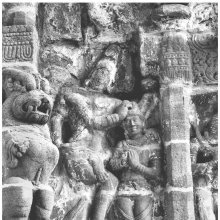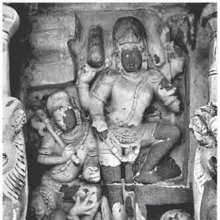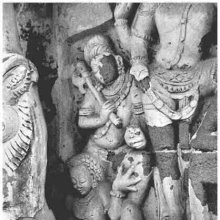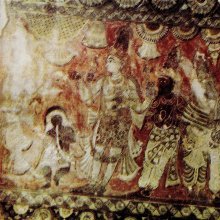Candesha, Canda-isha, Caṇḍeśa: 6 definitions
Introduction:
Candesha means something in Hinduism, Sanskrit. If you want to know the exact meaning, history, etymology or English translation of this term then check out the descriptions on this page. Add your comment or reference to a book if you want to contribute to this summary article.
The Sanskrit term Caṇḍeśa can be transliterated into English as Candesa or Candesha, using the IAST transliteration scheme (?).
Alternative spellings of this word include Chandesha.
Images (photo gallery)
In Hinduism
Shaivism (Shaiva philosophy)
Source: Wisdom Library: ŚaivismCaṇḍeśa (चण्डेश) is the Sanskrit name of a deity presiding over Kurujāṅgala, one of the sixty-eight places hosting a svāyambhuvaliṅga, which is one of the most sacred of liṅgas according to the Śaivāgamas. The list of sixty-eight svāyambhuvaliṅgas and presiding deities (e.g., Caṇḍeśa) is found in the commentary on the Jirṇoddhāra-daśaka by Nigamajñānadeva. The word liṅga refers to a symbol used in the worship of Śiva and is used thoughout Śaiva literature, such as the sacred Āgamas.

Shaiva (शैव, śaiva) or Shaivism (śaivism) represents a tradition of Hinduism worshiping Shiva as the supreme being. Closely related to Shaktism, Shaiva literature includes a range of scriptures, including Tantras, while the root of this tradition may be traced back to the ancient Vedas.
Shilpashastra (iconography)
Source: Archaeological Survey of India: Śaiva monuments at Paṭṭadakal (śilpa)Caṇḍeśa (चण्डेश) is found as a sculpture at the temple of Lokeśvara, north entrance, western side, north façade.—Caṇḍeśa is one of the dvārapālaka of the northern door according to the Somaśambhupaddhati (vol. II, p. 46). He is standing with crossed legs; right foot placed behind the unbent left leg. By the side of his right is placed a mace with head down and on the top of it rests his lower right hand. In the upper right he holds a snake and in the corresponding left the attribute is not clear, whereas the lower left rests on his left hip. He wears a ghanṭāmālā which descends down to his feet. It is a very comely image with all the ornaments and a handsomely carved tiara on his head.

Shilpashastra (शिल्पशास्त्र, śilpaśāstra) represents the ancient Indian science (shastra) of creative arts (shilpa) such as sculpture, iconography and painting. Closely related to Vastushastra (architecture), they often share the same literature.
Languages of India and abroad
Sanskrit dictionary
Source: DDSA: The practical Sanskrit-English dictionaryCaṇḍeśa (चण्डेश).—an epithet of Śiva; पुण्यं यायास्त्रिभुवनगुरीर्धाम चण्डीश्वरस्य (puṇyaṃ yāyāstribhuvanagurīrdhāma caṇḍīśvarasya) Meghadūta 33. °मण्डनम् (maṇḍanam) poison (kālakūṭam); मथ्यमानोऽद्रिणा पूर्वं ददौ चण्डीशमण्डनम् (mathyamāno'driṇā pūrvaṃ dadau caṇḍīśamaṇḍanam) Bm.1.13.
Derivable forms: caṇḍeśaḥ (चण्डेशः).
Caṇḍeśa is a Sanskrit compound consisting of the terms caṇḍā and īśa (ईश). See also (synonyms): caṇḍyīśa, caṇḍeśvara, caṇḍyīśvara, caṇḍāpati, caṇḍīpati.
Source: Cologne Digital Sanskrit Dictionaries: Monier-Williams Sanskrit-English DictionaryCaṇḍeśa (चण्डेश):—[from caṇḍa > caṇḍ] Name of a Liṅga, [Liṅga-purāṇa]
[Sanskrit to German]
Sanskrit, also spelled संस्कृतम् (saṃskṛtam), is an ancient language of India commonly seen as the grandmother of the Indo-European language family (even English!). Closely allied with Prakrit and Pali, Sanskrit is more exhaustive in both grammar and terms and has the most extensive collection of literature in the world, greatly surpassing its sister-languages Greek and Latin.
See also (Relevant definitions)
Starts with: Candeshadhipati, Candeshadhipatimurti, Candeshanugraha, Candeshanugrahamu, Candeshanugrahamumurti, Candeshanugrahamurti, Candeshapratishtha, Candeshapuja, Candeshasthapana.
Query error!
Full-text (+2): Candeshadhipati, Candeshasthapana, Candeshanugraha, Candeshapratishtha, Candeshapuja, Candadravya, Candapati, Candipati, Candeshvara, Bhaktanugraha, Kurujangala, Anugrahapratishtha, Trimurtisthapana, Guhasthapana, Vishnumardhapratishtha, Vishnumardha, Vishnuma, Vrisharudhapratishtha, Gangadharapratishtha, Shivabhaktapratishtha.
Relevant text
Search found 11 books and stories containing Candesha, Caṇḍā-īśa, Canda-isa, Canda-isha, Caṇḍeśa, Candesa; (plurals include: Candeshas, īśas, isas, ishas, Caṇḍeśas, Candesas). You can also click to the full overview containing English textual excerpts. Below are direct links for the most relevant articles:
Isanasivagurudeva Paddhati (study) (by J. P. Prajith)
34. Description of Candesvara (rites and rituals) < [Chapter 4 - Worship of Gods and Goddesses]
12. Description of Nityotsava-vidhi (festival rites) < [Chapter 4 - Worship of Gods and Goddesses]
2. Worship of Shiva in Isanasivagurudeva-paddhati (Introduction) < [Chapter 4 - Worship of Gods and Goddesses]
Padma Purana (by N.A. Deshpande)
Chapter 167 - Caṇḍeśa-tīrtha and Gaṇa-tīrtha < [Section 6 - Uttara-Khaṇḍa (Concluding Section)]
Notices of Sanskrit Manuscripts (by Rajendralala Mitra)
Page 395 < [Volume 12 (1898)]
The Religion and Philosophy of Tevaram (Thevaram) (by M. A. Dorai Rangaswamy)
Nayanar 20: Chandeshvara (Candesvara) < [Volume 4.1.1 - A comparative study of the Shaivite saints the Thiruthondathogai]
Chapter 4.5 - Puranic personalities (in the Tevaram) < [Volume 2 - Nampi Arurar and Mythology]
Chapter 1.1 - Arurar’s Language of Mythology < [Volume 2 - Nampi Arurar and Mythology]
Expiatory Rites in Keralite Tantra (by T. S. Syamkumar)
Concept of Nirmālya (in Śaiva ritual manuals) < [Chapter 3 - Expiatory Rites in Kerala Tantric Ritual Manuals]
Agni Purana (by N. Gangadharan)



